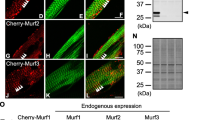Abstract
DURING development of skeletal muscle, and after denervation or reinnervation of adult muscle, there are significant changes in the number of extrajunctional acetylcholine (ACh) receptors, measured both by sensitivity to ACh and by binding of α-125I-bungarotoxin (for review, see ref. 1). Muscle activity has been shown to be a major factor in controlling the level of extrajunctional receptors. Direct electrical stimulation of denervated muscle both in vivo and in vitro decreases the sensitivity of the extrajunctional membrane to ACh2–5, whereas chronic postsynaptic blockade of innervated muscle in vivo increases its sensitivity6,7. Muscle activity could alter the level of extrajunctional receptor by changing rates of synthesis or degradation of the receptor.
Similar content being viewed by others
References
Harris, A. J., A. Rev. Physiol., 36, 251 (1974).
Jones, R., and Vrbová, G., J. Physiol., Lond., 210, 144–145P (1970).
Lømo, T., and Rosenthal, J., J. Physiol., Lond., 221, 493–513 (1972).
Drachman, D. B., and Witzke, F., Science, 176, 514–516 (1972).
Purves, D., and Sakmann, B., J. Physiol., Lond., 237, 157–182 (1974).
Berg, D. K., and Hall, Z. W., J. Physiol., Lond., 244, 659–676 (1975).
Chang, C. C., Chuang, S.-T., and Huang, M. C., J. Physiol., Lond., 250, 161–173 (1975).
Berg, D. K., and Hall, Z. W., Science, 184, 473–475 (1974).
Berg, D. K., and Hall, Z. W., J. Physiol., Lond., 252, 771–789 (1975).
Chang, C. C., and Huang, M. C., Nature, 253, 643–644 (1975).
Devreotes, P., and Fambrough, D., J. Cell Biol., 65, 335–358 (1975).
Brockes, J. P., and Hall, Z. W., Proc. natn. Acad. Sci. U.S.A., 72, 1368–1372 (1975).
Devreotes, P., and Fambrough, D., Proc. natn. Acad Sci. U.S.A., 73, 161–164 (1976).
Goldberg, A. L., Jablecki, C., and Li, J. B., Ann. N. Y. Acad. Sci., 228, 190–201 (1974).
Author information
Authors and Affiliations
Rights and permissions
About this article
Cite this article
HOGAN, P., MARSHALL, J. & HALL, Z. Muscle activity decreases rate of degradation of α-bungarotoxin bound to extrajunctional acetylcholine receptors. Nature 261, 328–330 (1976). https://doi.org/10.1038/261328a0
Received:
Accepted:
Published:
Issue Date:
DOI: https://doi.org/10.1038/261328a0
- Springer Nature Limited
This article is cited by
-
Regulation of acetylcholine receptor density in membranes of denervated mouse muscles
Pfl�gers Archiv European Journal of Physiology (1983)
-
Electrical stimulation of denervated muscles reduces incorporation of methionine into the ACh receptor
Nature (1977)
-
Decrease of acetylcholine receptor synthesis in muscle cultures by electrical stimulation
Nature (1976)
-
Selective stabilisation of developing synapses as a mechanism for the specification of neuronal networks
Nature (1976)
-
Acetylcholine receptor degradation measured by pulse chase labelling
Nature (1976)





